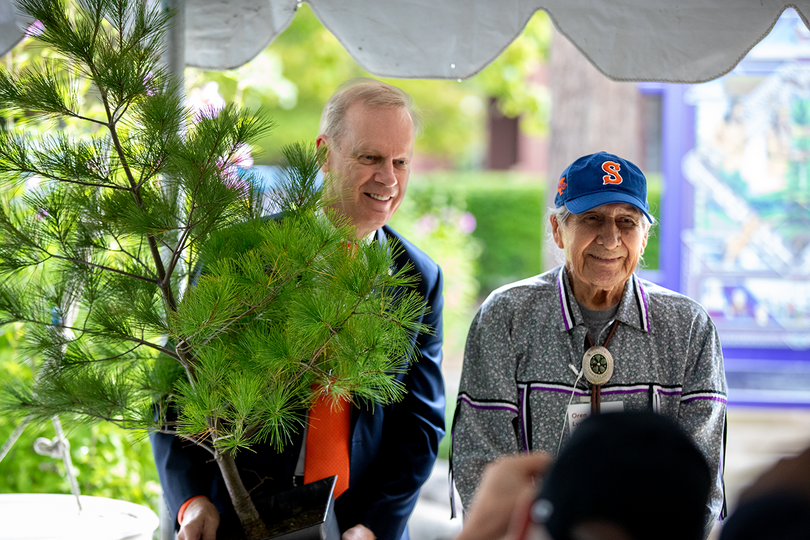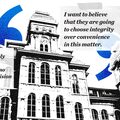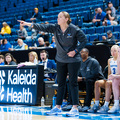SU to preserve documents collected by Oren Lyons, per stewardship agreement

Syracuse chancellor Kent Syverud (left) holds a tree the university plans to plant to honor Oren Lyons (right), a gesture made Friday alongside an agreement for SU to house Indigenous documents. Leonardo Eriman | Photo Editor
Get the latest Syracuse news delivered right to your inbox. Subscribe to our sports newsletter here.
Syracuse University Chancellor Kent Syverud held up an Eastern White Pine tree. To his right stood Oren Lyons, the legendary Haudenosaunee Faithkeeper of the Wolf Clan.
The tree was chosen by Deganawidah — the founder of the Haudenosaunee — to be a symbol of peace within their culture. The needles of the tree grow in clusters of five, meant to symbolize the end of the war between the five nations. Its tall structure symbolizes the comfort and great peace it provides to its members.
Syverud plans to plant the tree on the SU quad as an everlasting memory of Lyons. The 95-year-old has spent five decades preserving native culture through his advocacy for Indigenous rights. During that time, he amassed a collection of documents that’s remained untouched.
On Friday, SU and Lyons agreed to donate the material to Syracuse’s Special Research Collections Center through a “joint stewardship agreement,” keeping his and the Haudenosaunee legacy alive.
“This is a happy day,” Syverud said Friday. “This is a historic day because once again, Oren Lyons has done something that nobody else has ever done before.”
The collection — which includes letters, notes, documents, artwork and photographs — is one of a kind. They’ve piled up in various places. Nobody, not even Lyons, has gone through them. Until now.
Lyons was honored during a ceremony on the quad Friday. Indigenous leaders from the Haudenosaunee, including Tadodaho Sid Hill as well as Syracuse officials, attended.
Syverud said that the collection will be “the most significant archive of contemporary Indigenous leaders in the United States.” It’s part of a larger effort from the Chancellor to keep the memory of the Haudenosaunee relevant, whose land Syracuse now stands on.
Lyons’ footprint at SU is enormous. He was its first Indigenous athlete, twice earning All-American honors as a lacrosse goalie. There’s a level of trust between him and the university.
“A lot has changed since he came here,” Syverud said. “He has really helped transform this place.”

Oren Lyons stands at the podium to discuss his agreement with Syracuse on Friday. Lyons has continuously activated for Indigenous rights, including the inclusion of the Haudenosunee Nationals in the Olympics. Leonardo Eriman | Photo Editor
There are over 450 self-identifying Indigenous students at SU, Syverud said, while the school has “thriving Native American academic and cultural programs on campus.”
The Chancellor has tried his best to respect the Indigenous community, he said. When taking over for Nancy Cantor in 2014, Syverud introduced the policy that at every public event, it’s required to acknowledge that Syracuse lies on stolen land.
Friday, Syverud said Syracuse remained committed to that cause, pointing to schools like Ohio State that banned land acknowledgements this week. The erasure of Indigenous history is strongly condemned by Syverud, which is why Friday’s event was significant.
Lyons never had a process for organizing his material. His responsibilities as the leader of the Haudenosaunee took up too much of his time. Lyons is the modern face of promoting Native American culture. He’s given speeches at the United Nations, met with presidents and even formed the Iroquois National lacrosse team, now known as the Haudenosaunee Nationals.
A self-described “pack rat,” the documents piled up in his basement and a half-abondoned cabin he owned. Going through them became an afterthought. About 15 years ago, Lyons was curious. He popped open the lid of a random waterlogged box in his basement. The first sheet of paper was a letter from Ronald Reagan, the 40th President of the United States.
“There’s no telling what’s in those boxes,” Lyons said.
For years, Philip Arnold, an Associate Professor of the Department of Religion at SU, begged Lyons to create a plan for the material. He didn’t want them to get lost. It wasn’t until a couple years ago when Lyons told Arnold he wanted to take action.
Arnold, the President of the Indigenous Values Initiative non-profit, helped secure funding for the trucks needed to move the material and store them just south of Syracuse’s campus. Arnold estimated there’s about 200 linear feet of material, which fills two storage units. Sifting through everything will require a careful process.
Arnold reached out to Nicolette Dobrowski, the director of the Special Collections Research Center, to start a dialogue around the documents. The center, located on the sixth floor of Bird library, welcomes students, faculty, staff and the wider public to engage with the collections through research, education, exhibitions and public programming, according to Dobrowski.
It’s a perfect place for Lyons to store the belongings. Dobrowski, Arnold and Lyons met every couple months to talk things over. As talks ramped up, meetings became monthly, and recently, they were weekly.
Eventually, they signed the agreement, which outlines that Lyons and SU would partner together throughout the process. Typically once collections are donated, they become university property. With Lyons, it’s different. The university wants to make sure sensitive material that could be important to his family or the Haudenosaunee remains with them.
Per Dobrowski, the practice for preserving Native American archival materials was created in 2007 by a coalition of Indigenous and non-Indigenous archivists, librarians, museum professionals and others. Syverud said if the Haudenosaunee ever create a library with a special collection of their own, the material will be transferred to them. For now, it’s in SU’s hands, but Syverud hopes it’s temporary, so the Haudenosaunee can show off their own history.
“These protocols establish the best practices for working with indigenous materials housed in non-Indigenous institutions,” Dobrowski said. “It’s a very important distinction, and at the heart of the protocols is a fundamental principle that indigenous peoples and nations have the right to manage, interpret and control their own cultural heritage.”

Members of Friday’s ceremony, including SU Chancellor Kent Syverud, Oren Lyons, spiritual leader of the Onondaga nation Tadodaho Sid Hill and Syracuse professor Phillip Arnold, pose on Syracuse’s quad. The group came together to agree to house Indigenous documents in SU’s Special Research Collections Center. Leonardo Eriman | Photo Editor
Dobrowski called the collection “transformative.” David Seaman, the Dean of Libraries at Syracuse, labeled it a “treasure trove,” while Arnold struggled to put the significance into words.
“People from all over the world are going to want to look at these papers for a variety of reasons,” Arnold said. “(It) could be environmentalists, indigenous lawyers, or activists, or all kinds of people that would be really interested in what Oren has unearthed.”
“There really is no other Native American leader that has put themselves at the center of so much around the world. He is fearless in that way, and I think in that sense, this collection will continue to have an impact in the world.”
The pact is just the start. The brunt of the work remains. Dobrowski said there was some pre-processing done by Lyons’ family, but most of the boxes don’t have timestamps, nor are they labeled with the information inside. Lyons said 85% of the material might be nothing, but the 15% that’s useful will be crucial.
Organizing everything in a coherent manner will be a time-consuming process, though it’s an important mission for Dobrowski. She said the SCRC’s work is not only about preserving the past, but helping shape the future. That means ensuring that stories, experiences and voices of yesterday and today are preserved and made available to guide and inspire generations to come.
Lyons has spent decades spreading awareness about Indigenous culture. At his age, there’s no guarantee how much longer he’ll be able to spread his gospel.
That’s why the catalog is so crucial. No piece of paper will ever be able to connect with people on a personal level like Lyons does. But the materials can act as a form of teaching for curious individuals.
Decades from now, scholars will read about Lyons’ legend and discover an extraordinary individual. Someone who pushed boundaries and whose impact on Indigenous peoples can’t be understated.
And, for now, the best place to study Lyons and the Haudenosaunee will be on the top floor of Bird Library.
“I want to thank Oren for putting his faith in this university,” Syverud said. “It’s a privilege we take very seriously. We’re going to honor this privilege, not just today, but for as long as we’re asked to do so.”






